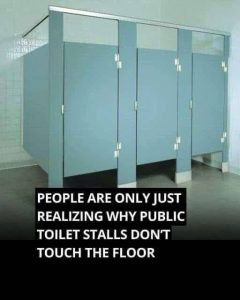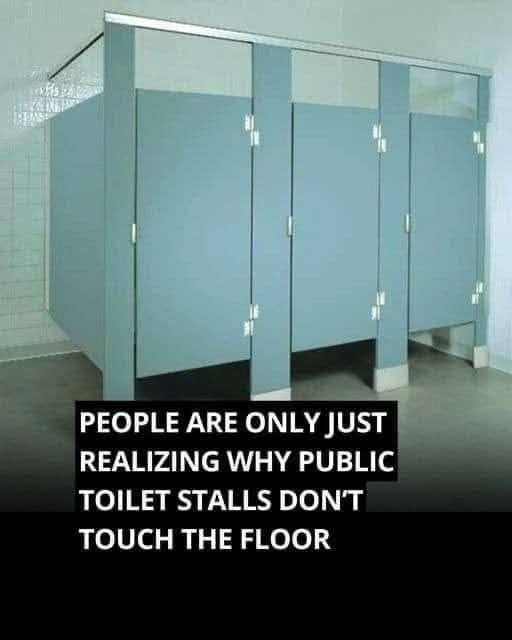You walk inside the stall, slam the door shut, and there it is again: a four-inch divide between your shoes and the rest of the world. People have been confused, angry, and amused by the small opening at the bottom of public restroom stalls for years. It seems like a bizarre design choice because it’s too small to crawl through but big enough to make it impossible to have any privacy. It seems like a flaw in something that most people require. But that little gap is actually a well-thought-out design that puts safety, usefulness, and even a little bit of cultural philosophy first.
The most practical reason is that it cleans very well. For commercial janitorial operations, speed and consistency are quite important. In venues like airports, malls, schools, and stadiums where a lot of people frequent, cleaning crews have to clean dozens or even hundreds of stalls every day. Mops and brooms can easily get under the doors while they are open. You don’t have to unlock every stall. You don’t have to reach around sharp edges. It’s a long, smooth sweep. This technique isn’t only about being simple; it’s also about being clean. If there wasn’t a space, it would be hard to get to the bottoms of locked stalls, which would be full of spills, bacteria, and other disgusting stuff. The gap makes sure that doesn’t happen.

Let’s speak about how air moves now. When there are a lot of people in a public bathroom if it isn’t kept clean, it might be stuffy and smell terrible. The strip at the bottom and the smaller openings at the top enable air circulate about on its own, which makes ventilation much better. Like a chimney, new air comes in and stale, stinky air goes out. Without this air exchange, even the greatest ceiling fans would have a hard time keeping the environment comfortable.
Safety is another crucial but frequently overlooked factor for the design. One of the few areas where people are purposefully kept alone behind locked doors is in public restrooms. That privacy is important, but it also has a risk: what if someone passes out inside and can’t get help? This isn’t simply a possibility; it’s happened a lot of times. People have experienced seizures, overdoses, heart attacks, or fainted in private. It’s hard to tell if someone is unconscious if there aren’t any openings at the bottom of the stalls. And how can you get into a locked door from the outside? Without tools or damaging the building, it is almost impossible to unlock a door from the outside.
But you can notice right away with the space at the bottom. You can see someone’s legs if they are in trouble. You can knock and get an answer, or you can’t. In the worst case, first responders can reach under the door or use the space to unlock it. A facilities manager reported that a janitor observed a man’s feet laying still under a stall. Because of this visibility, paramedics were able to save his life.
Don’t forget to be polite. You know what it’s like to push on a door and find it locked. That’s why you knock. No answer. You move the handle. Not yet. Then the frightening scream comes: “Occupied!” It’s not good for either side. But the space at the bottom makes it easy to tell if someone is inside without all the trouble. You can avoid the awkward dance by swiftly gazing at your shoes or the shadows. It’s a small gesture of compassion that helps keep traffic moving in crowded areas.
It’s remarkable that this simple design can even assist curb bad behavior. Closed, private stalls are more likely to encourage negative conduct, such as vandalism, drug use, loitering, or worse. But people are less likely to transgress the rules when they know that others can see through the door, even a little bit. It doesn’t seem like it would work, but it does. Psychologists call this “the illusion of surveillance.” The private space doesn’t appear so secret anymore when you add a little light and visibility.
You might be wondering why we don’t just put in full-length stalls. In places like Germany, Japan, and France, stalls often stretch all the way up to the roof, so you may be completely alone. The answer is the philosophy of cultural design. In North America, the design of public restrooms altered so that they were more about how they work than how they look. That means that it’s easy to get to, clean, and has useful safety features. On the other hand, many European countries put privacy and human dignity first in public areas. Because of their culture, they are ready to pay more for materials that last and tougher building requirements.
Another item to think about is the price. Making, shipping, and putting up shorter doors and walls costs less. Because shorter doors and partitions are lighter, they need lighter hinges and don’t get as much stress over time. For big events that put in dozens of stalls, those savings might add up quickly. The design wasn’t based on cost alone, although it does assist keep it in place.
But maybe the finest thing about its open-bottom design is how it makes us feel, even if we don’t know it. Public restrooms are intrinsically dangerous locations. You feel linked when you see something from the outside world, like a shadow or a footstep. It reminds you that you’re not the only one. It reminds you that there is always someone else close by. That little bit of comfort counts a lot more than we think when you feel exposed or frightened.
And certainly, it’s not the best thing ever. There are some issues. People don’t like how uncomfortable, visible, and private it is. People who are shy, anxious, or just want their own privacy might not like the open-bottom stalls and might even feel embarrassed. These fears are true, and some modern designs are already shifting to use tighter gaps, tilting walls, or patterns that are only partially private to establish a balance between privacy and function.
That little compartment at the bottom of your lavatory cubicle is still one of the most misunderstood yet vital components of public buildings. It doesn’t want you to say thank you. It doesn’t even say where it is. It’s discreetly taking care of you while you’re busy with your business.
So the next time you’re sitting there and staring at the floor, wondering why you can see the other person’s shoes, remember that that small gap is accomplishing more than you think.
